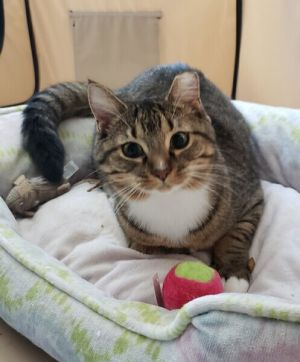Last week we considered dogs by the numbers. Today we ought to consider shelter cats by the numbers. But of course the situation is different for cats, because cats have fewer variant genes than dogs have. There are fewer breeds of cats, and the most common breed in shelters is always the Domestic Short Hair--American Short Hair in the US, British Short Hair in the UK.
What else can Petfinder's counter tell us about shelter cats?
Age: Cats are likely to be brought to shelters at any age. In spring there may be a higher number of kittens, while in autumn and winter there are more adults. The numbers are close and may vary among different shelters or cities. Geriatric cats may be the least common age group in shelters simply because most cats who live more than ten years are beloved pets who don't stray and aren't given up for adoption.
Size: More cats are medium-sized (about 10 pounds) than are small, large, or extra-large. Shelter populations reflect this tendency.
Gender: Female cats tend to be easier to live with than males. More male than female cats seem to land in shelters though in some cities the mix is even, or even reversed.
Color: More cats are some colors than others. The reason why Petfinder tends to show more black, white, gray tabby, and orange tabby cats, in that order, than any other color is that a majority of all cats are black, white, gray tabby, or orange tabby, in that order. There aren't a lot of Dilute Tortoiseshell or Flame Point Siamese cats.
The special features and qualities cats have tend not to be noticed, except by "cat people." Cat breeders and fanciers might rhapsodize about a Tiger-Striped Tabby Maine Coon Cat, but even shelter staff are likely to describe such an animal as merely "Calico, Medium hair, Large." Shelter staff are likely to notice, eventually, if they're harboring a Social or Listening cat, but those qualities are not obvious at first sight.
So these cats aren't in special needs of homes because of their DNA; they're the most common types of cats in their shelters because they're the most common types of cats in North America. They are the individuals of their type who appeared in the most eye-catching photos on their Petfinder pages.
Zipcode 10101: Old George
His web page: https://www.petfinder.com/cat/george-60879712/ny/new-york/anjellicle-cats-rescue-ny488/
He looks like an ordinary orange tabby and white cat. Do not be deceived. If there's anything to the biography on his web page, George is quite a noteworthy cat. He's believed to have survived for more than ten years, much of that on the streets, with FIV. If you're limited to only one cat in a house or flat, George would be an excellent choice. With a locked-down and quarantined sort of life George might live another five to seven years. He likes to snuggle, and has learned to watch videos.
Zipcode 20202: Paisley (and Panda, Patches, and Penguin) from D.C.
Her web page: https://www.petfinder.com/cat/paisley-16014-69018843/dc/washington/city-dogs-city-kitties-rescue-dc22/
An ordinary looking gray and white cat, Paisley is on the large side. She might hug your leg, and her hugging point might be above your knee. She became a shelter cat because she is a single mother. If two of her three kittens were adopted together and one was adopted with her, that would be ideal. The kitten Patches is a real Amber-Eyed Silver Tip.
Zipcode 30303: Sprout from Atlanta
Though she's been well lfed, Sprout doesn't seem to be growing any bigger. She is probably just going to be an undersized cat.



No comments:
Post a Comment